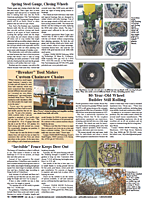You have reached your limit of 3 free stories. A story preview is shown instead.
To view more stories
(If your subscription is current,
click here to Login or Register.)
Bamboo Might Be Forage Of The Future
When most people think of bamboo, they picture an image of a giant black and white panda nibbling bamboo shoots in the mountains of China. Replace that image with one of Jim Criger, of Springfield, Mo., harvesting bamboo stalks to feed his horses and goats in the wintertime and you’ll have an idea of why bamboo might
..........
You must sign in, subscribe or renew to see the page.

You must sign in, subscribe or renew to see the flip-book
Bamboo Might Be Forage Of The Future CROPS Miscellaneous When most people think of bamboo they picture an image of a giant black and white panda nibbling bamboo shoots in the mountains of China Replace that image with one of Jim Criger of Springfield Mo harvesting bamboo stalks to feed his horses and goats in the wintertime and you’ll have an idea of why bamboo might some day become a great sustainable forage for North American farmers What is it about bamboo that makes it such a fantastic forage option? Jim has found that bamboo will grow where other forages will not Such as rocky or swampy areas that might otherwise be wasted space There is no need to take up valuable pasture space to grow a successful bamboo stand Jim is a smaller scale farmer and says that he does not have a large enough farm to justify purchasing the equipment to cut bale and store hay Bamboo works for Jim because his stand can be maintained by hand at little to no cost – the only money he has invested in it was his initial output to purchase the starter plants which cost between $20 and $50 per pot Jim has had his bamboo stand for 3 1/2 years It takes between 2 to 3 years to establish a mature enough stand for it to be fed sustainably He harvests his bamboo stalks using a brushcutter tool that has a high-powered weed eater motor with a circular metal blade combined with chainsaw teeth at the end The protein content of bamboo is high rivaling good alfalfa One of Jim’s favorite varieties Bissetii has a spring protein content of 15 17% and a winter protein content of 21 55% The percentage of protein varies among different varieties of bamboo but one thing they all have in common is that the nutritional levels are highest in the winter Jim recommends cutting back the stand no more than 50 percent during the harvest season That way what has been cut will grow back the following year and what has been left will already be established for the next harvest season Bamboo will sprout once a year typically around May so taking care to not cut a stand back completely each harvest season will ensure the long lasting success of a stand Bamboo can be fed to most livestock – horses cattle pigs and other farm critters will all benefit from the high levels of nutrients within the stalks Jim says that his goats are especially fond of the exotic roughage As far as challenges to growing a bamboo stand go Jim says “There isn’t one It’s super easy ” With such high protein content and such low maintenance Jim expects many more farmers to catch onto this unique form of fodder Contact: FARM SHOW Followup Jim Criger 2986 N Farm Rd 103 Springfield Mo 65803 jimc417@yahoo com
To read the rest of this story, download this issue below or click
here to register with your account number.





